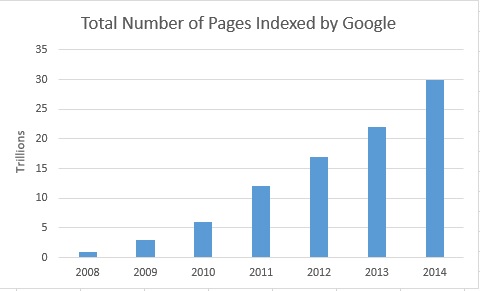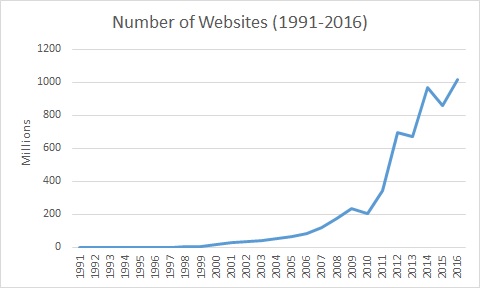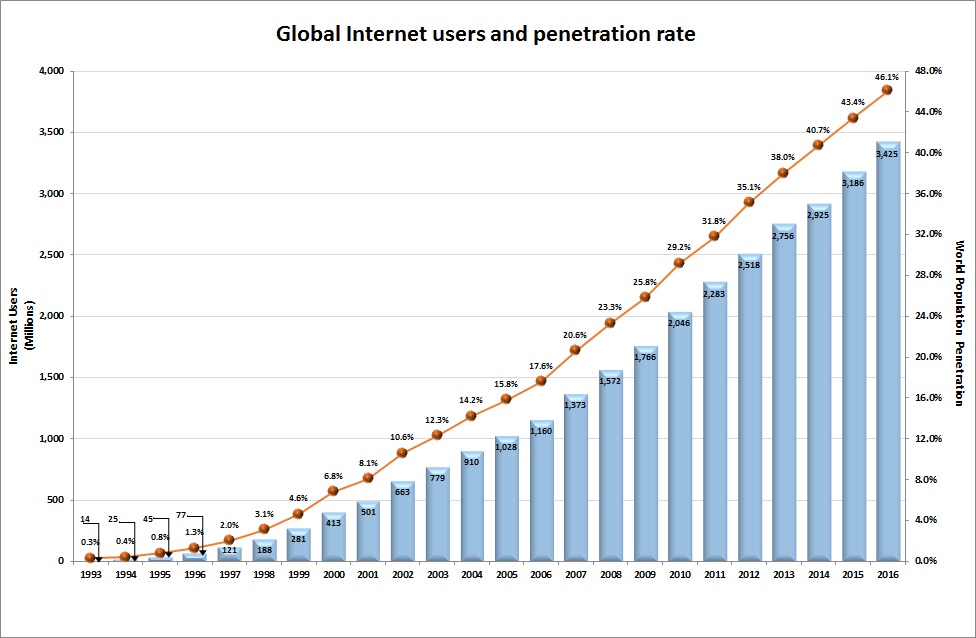
Based on the most recent data available, Google had indexed more than 30 trillion individual web pages across 1 billion web sites in 2014, according to StatisticBrain. Only 5 years earlier, that number was “just” 3 trillion, and in 2008, Google’s index had 1 trillion pages. In other words, the number of pages on the web increased by 900% in just 5 short years.
To store this information, Google uses more than 920,000 servers and stores more than 100 billion gigabytes of data. Google’s internet storage capacity needs are so massive, they account for more than 0.01% of the total worldwide electricity usage. Think about that.
The internet is seeing exponential growth with each passing year, both in terms of the number of pages as well as the total number of active users.
In total, there are more than 1 billion websites on the Internet. Most of those websites will never be visited by a real, live user, and instead play to an audience of crawl and spam bots. However, the average person is interacting with more web pages on a daily basis than ever before, and we can expect that trend to continue.

What is Driving the Growth in Web Pages?
The growth in the total number of web pages is driven by several different factors. As the internet has continued to grow and evolve, the old cliche’ that “content is king” continues to ring true for companies of all sizes.
Companies are publishing more content than ever, and they don’t just create and publish that content for fun. Today the Washington Post publishes more than 1,200 pieces of content per day.
While one might think that this inhibits their ability to control the quality of their content (and it likely does), the Washington Post has enjoyed incredible growth that can be directly attributed to their blanket-content strategy. The Washington Post has seen their visitors grow more than 28% over the last year. They even managed to surpass the New York Times in late 2015.
This is one example of companies ramping up their content publishing efforts and reaping the benefits. But where is the demand for this content coming from? Companies wouldn’t publish 1,200 pieces of content per day unless it was paying off on the backend.

- More internet users means more eyeballs. The internet is growing. In 2007, there were roughly 1.5 billion internet users around the world. In 2016, that number is expected to grow to 3.4 billion. That is approaching 50% of the total world population. With massive efforts underway to connect third-world nations with first-world internet, we can expect to see this number growing for quite some time. With more users seeking out content online, there is an ever-growing need to produce it and lay claim to “content homesteads.”
- The average user is interacting with more content as time goes on. With the rapid adoption of mobile devices, the internet increasingly entrenching itself in our lives (social media, internet of things, etc.), and the rapid rises in cord cutting, people are simply interacting with more content every day. Whether they are watching a movie on Netflix, reading their favorite blog, or clicking on a link through social media – the same number of eyeballs are consuming more content daily than ever before.
- Search engine optimization is driving content creation. With each passing year, Google becomes more adept at connecting searchers with the kind of content that they are writing. Did you know that between 16% and 20% of queries types into Google have never been asked before? That means there is a lot of uncovered ground. By creating content both manually and through automated means, companies know that they are covering their bases for the future. They are creating “content homesteads” that may not be worth much now, but will pay off for years to come.
- Content marketing continues to pay off for companies of all sizes. To put it simply – companies wouldn’t invest so much into the creation of new content if it wasn’t paying off for them. In the Washington Post example we mentioned earlier, they’ve been able to reseed their standing in the American newspaper market simply by ramping up their digital content creation and companies in other industries are seeing similar results.
There are many potential reasons why publishing more content has been such an attractive prospect for brands around the world. But will this trend continue into the future?
What the Future Holds for Google’s Index and Content Marketing
Will the trend of rapid increases in content publishing continue into the future?
Definitely. In fact, if anything, we will see the trend continue to grow for the foreseeable future. Some of the reasons why publishing content will continue to be beneficial for companies well into the next decade include:
- Many users left to bring into the fold. Yes, we are rapidly bringing a large number of users onto the internet. But even today, only half of the world’s population is currently using the internet. Those 3.5+ billion users that have never used the internet before will begin consuming content regularly within the next decade. Like western adoption of the internet, it will be slow at first. As time goes on the daily consumption of content for new users will continue to rise, albeit likely more quickly than it did for the west. Those non-connected people represent a huge opportunity for content consumption growth, not just by getting them connected, but by integrating the internet more deeply into their lives as we have seen in recent years.
- More points of connection in the future. The rise in mobile device usage was the first big swing toward increasing our number of connection points with the internet. Today, most walk around with an internet connection in their pocket. As time goes on, we see the “internet of things” revolution taking place. The number of access points to the internet that your average suer will have in their homes, on their person and in their place of work will grow rapidly over the next decade.
- Rise in automation. We’ve already seen the early effects that increases in automation will have on the world. As time goes on, automating the creation and publishing of content will rise in quality and become more accessible to companies of all sizes. Already, we see companies taking advantage of automation to produce basic fact-reporting articles. This is just the beginning, too. Companies will continually find ways to have AI solutions play roles in the content creation process.
The rapid growth in Google’s index is an excellent indicator for the direction of the internet as a whole – growth. Forward-thinking companies can see the writing on the wall. The rewards for companies that begin heavily investing in content now are apparent and will pay off for years to come.

Be the first to comment on "The Number of Pages Indexed by Google Increased 900% Over 5 Years"